阅读理解题型及解题方法分析
阅读理解9大题型+解题技巧
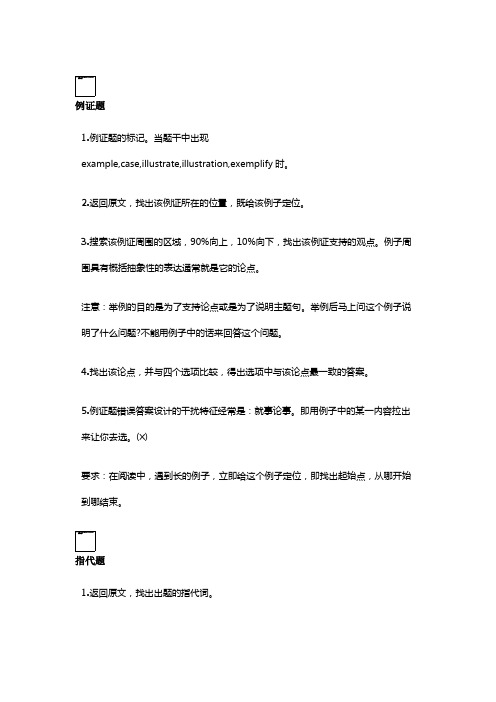
例证题1.例证题的标记。
当题干中出现example,case,illustrate,illustration,exemplify时。
2.返回原文,找出该例证所在的位置,既给该例子定位。
3.搜索该例证周围的区域,90%向上,10%向下,找出该例证支持的观点。
例子周围具有概括抽象性的表达通常就是它的论点。
注意:举例的目的是为了支持论点或是为了说明主题句。
举例后马上问这个例子说明了什么问题?不能用例子中的话来回答这个问题。
4.找出该论点,并与四个选项比较,得出选项中与该论点最一致的答案。
5.例证题错误答案设计的干扰特征经常是:就事论事。
即用例子中的某一内容拉出来让你去选。
(╳)要求:在阅读中,遇到长的例子,立即给这个例子定位,即找出起始点,从哪开始到哪结束。
指代题1.返回原文,找出出题的指代词。
2.向上搜索,找最近的名词、名词性短语或句子(先从最近点开始找,找不到再找次近的,一般答案不会离得太远)。
3.将找到的词、词组或句子的意思代入替换该指代词,看其意思是否通顺。
4.将找到的词、词组或句子与四个选项进行比较,找出最佳答案。
词汇题“搜索代入”法:①返回原文,找出该词汇出现的地方。
②确定该词汇的词性③从上下文(词汇的前后几句)中找到与所给词汇具有相同词性的词(如一下子找不到就再往上往下找),代入所给词汇在文章中的位置(将之替换)看语义是否合适④找出选项中与代替词意思相同或相近的选相,即答案注意:a.如果该词汇是简单词汇,则其字面意思必然不是正确答案。
b.高考阅读不是考察字认识不认识,而是考察是否能根据上下文作出正确的判断。
c.词汇题的正确答案经常蕴藏在原文该词汇出现的附近。
注意不能靠单词词义直接往下推。
d.寻找时要注意同位语、特殊标点(比如分号,分号前后两句话的逻辑关系不是形式上的并列就是语义上的并列,也就是两句话的意思相同,所以可用其中一句话的意思来推测另一句话的意思从而推出所给词汇含义)、定语从句、前后缀,特别要注意寻找时的同性原则。
初中阅读理解常见题型解题思路与答题技巧汇总

初中阅读理解常见题型解题思路与答题技巧汇总阅读理解是初中语文考试中常见且重要的题型。
掌握解题思路和答题技巧,能够帮助学生更好地理解文章,准确回答问题。
本文将汇总初中阅读理解常见题型的解题思路与答题技巧,以便学生在考试中取得好成绩。
常见题型一:主旨大意题主旨大意题要求学生理解整篇文章的中心思想。
解题思路包括以下几步:1. 首先,通读全文,抓住文章的中心思想。
注意作者可能通过标题、首尾段或者关键词语来暗示主旨。
2. 其次,根据题目中的选项,选择与文章主旨最相关的选项。
注意排除那些离题的选项。
3. 最后,再次快速浏览文章并核对所选答案,确保选项与文章的核心思想一致。
答题技巧:1. 有时候,题目中的关键词可能会出现在文章中,学生应该注意这些线索。
2. 题目中的细节信息不是文章的主旨,这样的选项应该排除。
常见题型二:事实细节题事实细节题要求学生从文章中找到特定的细节信息。
解题思路包括以下几步:1. 首先,读题目并确定需要查找的具体信息。
2. 其次,扫描文章并寻找包含所需信息的段落,注意细节词或关键词。
3. 最后,确认所找到的信息与题目相符。
答题技巧:1. 阅读文章时要有重点,注意找到题目中所需要的具体事实或细节。
2. 注意排除那些与题目无关的信息。
常见题型三:推理判断题推理判断题要求学生通过对文章中的信息进行推理和判断。
解题思路包括以下几步:1. 首先,综合考虑文章中的信息和自己的知识,理解文章的意思。
2. 其次,在文章中找到与题目相关的线索,通过推理判断来回答问题。
3. 最后,选择与推理判断一致的选项。
答题技巧:1. 综合运用文章中的信息和自己的常识进行推理判断。
2. 注意区分推理和直接事实,不要被干扰选项迷惑。
常见题型四:态度观点题态度观点题要求学生判断作者的态度或观点。
解题思路包括以下几步:1. 首先,读懂文章并理解作者所表达的意思。
2. 其次,注意作者在文章中使用的词语、句子语气等线索来判断态度或观点。
阅读理解题型及解题方法

阅读理解题型及解题方法在我们的学习和生活中,阅读理解是一项非常重要的技能。
无论是在学校的考试中,还是在日常的阅读中,能够准确理解文本的含义,并回答相关问题,对于获取信息和知识都至关重要。
接下来,让我们一起了解一下常见的阅读理解题型以及对应的解题方法。
一、主旨大意题主旨大意题主要考查对文章整体内容的理解和概括能力。
这类题目通常会问“这篇文章的主旨是什么”“文章主要讲了什么”等。
解题方法:1、快速浏览文章的开头、结尾以及每段的开头和结尾,这些地方往往会包含文章的关键信息。
2、注意文章中反复出现的关键词或短语,它们可能是文章的主题。
3、排除那些只涉及文章局部内容的选项,选择能够涵盖文章整体内容的选项。
例如,如果一篇文章开头介绍了某个现象,中间列举了相关的例子和原因,结尾提出了解决方案,那么主旨很可能是关于这个现象的分析和解决办法。
二、细节理解题细节理解题要求我们准确理解文章中的具体信息。
比如“文中提到______的原因是什么”“根据文章,______发生在什么时候”等。
解题方法:1、仔细阅读题目,明确题目所问的具体内容。
2、回到文章中,根据题目中的关键词定位相关的段落和句子。
3、认真比对选项和原文,注意细节上的差异,比如数字、时间、地点等。
需要注意的是,有时候选项中的表述可能与原文相似,但会在一些细微之处进行改动,所以一定要仔细辨别。
三、推理判断题推理判断题需要我们根据文章提供的信息进行推理和判断。
题目可能会问“从文章中可以推断出______”“作者暗示______”等。
解题方法:1、以文章的事实为依据,不能凭空猜测。
2、注意文章中的逻辑关系,如因果关系、转折关系等,这些关系有助于我们进行推理。
3、对于模棱两可的选项,要再次回到文章中寻找相关证据进行判断。
比如,如果文章中提到某产品的销量在不断上升,同时提到了该产品的质量得到了改进和宣传力度加大,那么我们可以推断出产品销量上升的原因是质量改进和宣传有效。
中考阅读理解题型及解题思路

中考阅读理解题型及解题思路阅读理解是中考语文考试的重点和难点之一。
许多同学在中考中失分较多的往往是因为对阅读理解题型和解题思路不够熟悉。
本文将介绍常见的中考阅读理解题型及解题思路,帮助同学们提高解题能力。
一、题型分析1. 主旨大意题这种题型常常出现在阅读理解的开头或结尾,要求从全文中找出文章的主旨大意。
解答这种题目的方法是先通读全文,了解文章的大致内容,然后再仔细阅读每个段落,逐步揣摩出作者的观点和观点所依据的事实依据。
2. 细节理解题这种题型要求根据文章的细节信息来进行判断或推断。
解答这种题目的方法是先找出题干中的关键词,然后再通读相关段落,全面了解该细节的相关信息,最后结合题干选出正确答案。
3. 推理判断题这种题型要求根据文章内容进行推理判断,有时也需要运用自己的常识和背景知识。
解答这种题目的方法是先找出题干中的关键词,然后在文章中找出相关信息,进行逻辑推理,最后选出最合理的答案。
4. 词义猜测题这种题型要求根据上下文推断生词的词义。
解答这种题目的方法是先找到生词所在的句子,然后根据上下文的暗示和语境来理解生词的意思,最后选出最符合句意的答案。
二、解题思路1. 抓住文章的结构和段落阅读理解的文章通常由引子、主体和结论构成。
读文章时应注意抓住文章的结构,了解每个段落的中心思想,这样可以更快地选出答案。
2. 留意词汇和关键句在阅读理解中,词汇往往起到关键作用。
在解题时要留意关键词和关键句,抓住文章的重点和作者的观点。
这有助于我们理解文章的内容和选出正确答案。
3. 注意文章的逻辑关系阅读理解中各个句子和段落之间往往有一定的逻辑关系,比如因果关系、转折关系等。
正确理解这些逻辑关系对于解题非常重要,因为很多题目需要我们根据逻辑关系来进行推理和判断。
4. 善于运用排除法当遇到一道不确定答案的题目时,可以尝试使用排除法。
先分析每个选项,将明显错误或不合适的答案排除,从而提高选对答案的概率。
总结:中考阅读理解题型及解题思路的掌握对于提高语文分数至关重要。
语文阅读理解专项解题技巧和例题及答案

阅读理解专项训练解题技巧和例题题型:一、结合全文,分析题目的作用技巧:1、题目的含义(表层和深层)1.把握象征意义2.语带双关2、题目的作用1.点名故事发生的地点2.交代环境3.交代描写对象4.设置悬念,引起阅读兴趣5.点明线索6.揭示主旨[例]本文着力描写母亲的白发,请简要分析标题中的“白发”在文中有哪些作用。
南京市《田野上的白发》[答案]“白发"是全文叙事线索(贯穿全文线索) ; “白发”是母亲的形象特征(表明写作对象;敲盆赶鼠、跪着插秧时的“白发",突出母亲的辛劳(关联主要情节) ; 表达出作者对母亲的心疼,对母亲的爱和怀念(透露情感主旨)。
二、段落在文章中的作用●开头1.总括总起全文,引出下文2.再分别从结构,内容上作答对上:开篇点题,照应题目开门见山,点出文章的主题本身:渲染气氛/突出表现……对下:引出下文/为下文做铺垫;与下文形成对照或呼应;设置悬念,激发读者阅读兴趣●中间段落1、总括过渡,承上启下。
2、(具体) 内容上、结构上作答:该段本身表达了(有手法结合手法) ;a.上承(或照应). 下启(或呼应)b.总括上文,为下文_ 作铺垫c.文章由转为●结尾段落1、结构上:或者回应了文章开头的提问;或者使文章前后照应;或者层层深入,总结全文。
2、内容上:①直白类--(本身)结尾部分表达了(有手法就结合手法回答) ,深化的主旨,强化的观点。
②含蓄类--a、使文章在表达上显得委婉含蓄,发人深思;b、有戛然而止,意在言外的余味;C、暗示主题,强化了作者的感情。
方法:首先看看段落在什么位置,然后从内容和结构.上分析。
三、请用简洁的语言概括文章叙述了一件什么事 | 请简要概括本文的主要内容。
1、必须包含两个要素:人物十事情;2、其他要素如:时间(季节、年代)、地点、环境如果有特定意义,也应概括在内。
回答清楚(什么时间、什么地点)什么人做什么事格式:谁+做了什么事+结果怎么样谁+在什么地方+发生了什么事+结果怎么样谁+在什么时间+发生了什么事+结果怎么样四、线索题(可以在分析主旨,或赏析题目,或分析故事情节发展时用到)2、以人物或人物的特征为线索。
小学阅读理解答题公式及技巧33种题型解题方法

小学阅读理解答题公式及技巧题型1:概括文章内容答:(时间+地点)+人+事记叙文:谁做了什么,用三句话把起因、经过,结果说清楚。
写景文:什么东西,怎么样。
题型2:这篇文章,你明白了什么道理?有什么感想?答:可以从文章最后一个自然段寻找答案,或者从文章的中心句下手。
写景文:一般是对景色的喜爱与赞美。
写人文:赞美主人公的某些优秀品质。
写物文:直接表达对某物的喜爱;或托物言志,表达自己的志向;或借物喻人,表达对某一类人的喜爱与赞美。
题型3:某个自然段的作用答:可以分成三段回答。
第一段:开门见山,总领全文。
落笔点题,点明主指。
交代故事背景,为下文埋下伏笔。
设置悬念,引起读者阅读兴趣。
中间段:承上启下,承接上文什么什么,启发下文什么什么。
(有的只有为下文埋下伏笔)。
最后一段:总结全文,点明主指。
首尾呼应,点题(省略号结尾还有留给读者想象的余地)。
题型4:概括文章主旨(中心意思)答:找寻文章的关键词作答。
答题公式:通过一个什么故事,歌颂了(赞美了)什么,表达了作者什么思想感情(揭示了一个什么道理)题型5:赏析划线句子(修辞手法)答:先看有没有修辞手法。
有的,答出使用了什么修辞手法。
答题公式:使用了什么修辞手法+解释修辞手法十修辞手法的作用十作者的情感。
①比喻、拟人:是生动形象地写出了对象的特点。
②对比:则是突出了所写对象的特点。
③排比:则是增强气势,强调突出所写对象④设问:则是引起读者的注意与思考。
⑤反问:则是加强了语气题型6:赏析划线句子(描写手法)答:先看有没有描写方法。
有的,答出使用了什么描写方法,各种描写无非都是为了突出描写对象的本质、特点或其中所蕴含的情感。
答题公式:使用了什么描写方法十解释描写方法十这种描写方法的作用+表达了什么思想或情感。
题型7:联系上下文解释词语答:找到该词语的近义词,用该词扩充成一句活来解释。
再结合文章,说说这个词在文章里具体的含义。
题型8:给文章起一个标题答:找出文章的主要事件或主要人物,给其加上一个特定的修饰词。
阅读理解题型
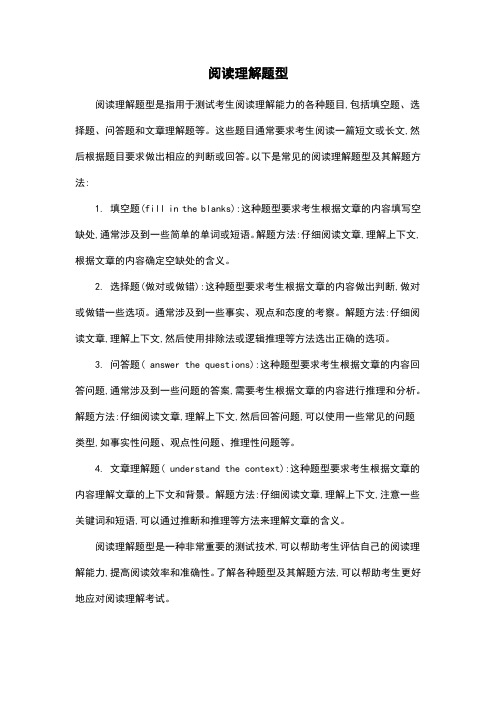
阅读理解题型
阅读理解题型是指用于测试考生阅读理解能力的各种题目,包括填空题、选择题、问答题和文章理解题等。
这些题目通常要求考生阅读一篇短文或长文,然后根据题目要求做出相应的判断或回答。
以下是常见的阅读理解题型及其解题方法:
1. 填空题(fill in the blanks):这种题型要求考生根据文章的内容填写空缺处,通常涉及到一些简单的单词或短语。
解题方法:仔细阅读文章,理解上下文,根据文章的内容确定空缺处的含义。
2. 选择题(做对或做错):这种题型要求考生根据文章的内容做出判断,做对或做错一些选项。
通常涉及到一些事实、观点和态度的考察。
解题方法:仔细阅读文章,理解上下文,然后使用排除法或逻辑推理等方法选出正确的选项。
3. 问答题( answer the questions):这种题型要求考生根据文章的内容回答问题,通常涉及到一些问题的答案,需要考生根据文章的内容进行推理和分析。
解题方法:仔细阅读文章,理解上下文,然后回答问题,可以使用一些常见的问题类型,如事实性问题、观点性问题、推理性问题等。
4. 文章理解题( understand the context):这种题型要求考生根据文章的内容理解文章的上下文和背景。
解题方法:仔细阅读文章,理解上下文,注意一些关键词和短语,可以通过推断和推理等方法来理解文章的含义。
阅读理解题型是一种非常重要的测试技术,可以帮助考生评估自己的阅读理解能力,提高阅读效率和准确性。
了解各种题型及其解题方法,可以帮助考生更好地应对阅读理解考试。
阅读理解常见题型解析

阅读理解常见题型解析阅读理解是考试中常见的题型,涉及到理解、分析和运用文本信息的能力。
以下是对几种常见的阅读理解题型的解析,希望能帮助你在考试中更好地应对。
题型一:主旨大意题主旨大意题要求从文章中抓住主题和核心观点。
解题方法包括以下步骤:首先,通读全文,了解文章的主题和结构;其次,关注标题、段落开头和结尾,以及作者给出的关键词语或主题句;最后,结合文章细节,选出最能概括文章主旨的选项。
题型二:细节理解题细节理解题要求根据文章中的具体信息来回答问题。
解题方法包括以下步骤:首先,通读全文,对文章的大意有一个整体的认识;然后,针对问题定位到相关的段落或句子;最后,通过细致阅读确定正确的答案。
题型三:推理判断题推理判断题要求根据文章中的暗示或推理出正确的结论。
解题方法包括以下步骤:首先,把握文章的主旨和观点;其次,分析文章中的信息,尤其是作者的态度和观点;最后,运用逻辑推理、常识和背景知识,进行合理的判断。
题型四:词义理解题词义理解题要求根据上下文推测词语的含义。
解题方法包括以下步骤:首先,根据词语在句子中的位置和上下文的语境,推测词义;其次,注意其他词语的搭配和语法关系,以便更准确地推测词义;最后,结合选项找到与之相符的答案。
题型五:作者观点态度题作者观点态度题要求判断作者在文章中的观点、态度或立场。
解题方法包括以下步骤:首先,理解文章的主题和论述思路;其次,注意作者在文章中的表述、论证方式,以及所使用的修辞手法;最后,分析作者的观点、态度,并选择与之相符的选项。
以上是对几种常见的阅读理解题型的解析。
在准备考试时,除了理解解题方法,还要加强对各类文章的阅读和分析能力的训练。
同时,积累一定的词汇量和相关背景知识也是提升阅读理解能力的关键。
希望你可以通过这些解析和练习,更好地应对阅读理解题,取得优异的成绩。
阅读理解常见题型

阅读理解常见题型在考试中,阅读理解是很常见的题型之一。
它要求考生根据所给的阅读材料,理解其中的信息,并回答相关问题。
下面将介绍一些常见的阅读理解题型及解题方法。
一、主旨大意题主旨大意题要求考生找出文章的中心思想或主题。
解答此类题目时,可以通过以下步骤进行:1. 综观全文,了解文章的结构和内容。
2. 寻找文章的标题或首段、尾段等含有关键信息的句子。
3. 总结文章的主要观点,归纳出文章的中心思想。
二、细节理解题细节理解题要求考生根据文章中的具体细节,回答问题。
解答此类题目时,可以采取以下方法:1. 仔细阅读问题,找出关键词。
2. 圈出问题涉及到的信息。
3. 在文章中找到与之相关的句子或段落。
4. 将问题与答案进行匹配,找到正确的答案。
三、推理判断题推理判断题要求考生根据文章的暗示或推断出一些新的信息。
解答此类题目时,可以考虑以下策略:1. 通过阅读全文,了解文章的背景和脉络。
2. 寻找文章中的线索和暗示。
3. 根据线索和暗示进行推理和判断。
4. 选择与文章意图相符的选项。
四、态度观点题态度观点题要求考生了解文章作者的立场或态度。
解答此类题目时,可以使用以下方法:1. 关注文章中的情感色彩和修辞手法。
2. 寻找关键词和表达方式。
3. 通过文章的语气和语句结构推断出作者的态度。
4. 选择与文章作者观点相符的选项。
综上所述,掌握常见的阅读理解题型及解题方法对于提高答题准确性和效率十分重要。
通过多做练习,同时注重阅读和理解能力的培养,相信大家在阅读理解题上会取得好成绩!。
语文阅读理解各种题型答题技巧

现代文阅读现代文阅读解题原则是:以“文解题”;看分值答题 (如果多分值最好标出1、 2 ,怕丢分不妨 n+1,但有字数限制的概括题除外 ) ;尽量用原句,不能用原句的,答题线索一定在附近;审题要细,别看错,别遗漏。
(一)、记叙文阅读一、词语:答题时一定要在文段句词的前后找答案或找解答的依据。
(1)能理解词语的表面意义,以及深层含义和言外之意,并能理解其表达的效果;(2)能确定词语指代的内容:一般出现在上文 ,找出后代入原文 ,看是否通顺合理。
二、文章概括:内容概括(一句话概括故事情节) :人物和事件( A、谁干什么 B 什么怎么样)主题概括:“本文通过某人做某事反映了什么意义(人物性格、作者感情、人生哲理)。
”主旨句的作用:结构上贯穿全文,内容上点明中心。
三、记叙线索及作用?线索:( 1 ) 核心人物 ( 2 ) 核心事物(3)核心事件 ( 4 ) 时间 ( 5 ) 地点 ( 6 ) 作者的情感。
作用:贯穿全文,把文中的人物和事件有机地连在一起,使文章条理清楚、层次清晰。
五、记叙顺序及作用?( 1 ) 顺叙(按事情发展先后顺序)作用:叙事有头尾,条理清晰,脉络清楚、印象深刻。
( 2 ) 倒叙:造成了……的悬念,使故事情节更曲折 ,增强了文章的可读性 .( 3 ) 插叙作用:补充交代了……使人物形象更丰富,使中心更突出。
记叙文中穿插议论的作用 :结构上承上启下 ;内容上画龙点睛 .六、文章段落语句的主要作用有: (必须从内容、结构两个方面来进行做答)1、结构上:承接上文、开启下文、总领下文 (引出下文) 、承上启下 (过渡)、照应前文(开头)首尾呼应。
2、内容上:开篇点题、抒发情感、点明中心,深化主题、画龙点睛某句话在文中的作用:1、)文首:开篇点题;渲染气氛(记叙文、小说) ,埋下伏笔(记叙文、小说) ,设置悬念(小说) ,为下文作辅垫;总领下文;2、)文中:承上启下;总领下文;总结上文;3、)文末:点明中心(记叙文、小说) ;深化主题(记叙文、小说) ;照应开头(议论文、记叙文、小说)3、写法上:气氛渲染、托物言志、以小见大、设置悬念、埋下伏笔、为后文作铺垫、欲扬先抑、借景抒情、寓情于景、托物言志等。
阅读题型和答题方法

阅读题型和答题方法阅读题型和答题方法阅读题型是指在阅读理解中常见的题目类型,包括主旨题、细节题、推理题、观点题、态度题等。
针对不同的题型,我们可以采取一些答题方法来提高解题效率。
1. 主旨题:主要考察文章的中心思想。
解答主旨题时,可以通过阅读首尾段、段落开头和结尾句来确定文章的中心思想。
关注作者的观点、态度和意图,找出文章的核心主题。
2. 细节题:要求从文章中找出具体的信息细节。
解答细节题时,需要仔细阅读相关段落,注意文章中的数字、日期、名称等具体细节。
如果有必要,可以在阅读过程中划线或做笔记,以便在回答问题时能够快速找到相关信息。
3. 推理题:要求根据文章中的信息进行推理判断。
解答推理题时,需要将文章中的隐含信息与已有的知识进行联系,进行逻辑推理。
注意文章中的因果关系、转折关系、比较关系等,从而得出正确的推理结论。
4. 观点题:要求理解作者的观点或态度。
解答观点题时,需要注意作者在文章中的表达方式和用词选择,以及作者对待问题的态度和观点。
可以通过寻找关键词、情感词和修辞手法来判断作者的观点。
5. 态度题:要求理解文章中的态度或情感色彩。
解答态度题时,需要关注作者对于所述事物的情感态度,包括赞扬、批评、中立等。
注意文章中的情感词、修辞手法以及语气的变化,从而判断作者的态度。
为了提高解题效率,我们还可以采取一些策略:1. 先读题后读文:在阅读文章之前,先快速浏览一遍题目,了解问题的要求和重点,这样在阅读文章时可以有目地地寻找相关信息。
2. 找准定位点:对于细节题,需要找准定位点,即文章中与题目相关的句子或段落。
可以通过关键词、指代词等进行定位。
3. 多练习多积累:通过多做阅读理解题,积累解题经验和技巧。
可以选择不同难度和题型的文章进行练习,并总结解题思路和方法。
总之,掌握不同题型的解题方法,结合阅读技巧和积累,可以在阅读理解中更加准确和高效地回答问题。
阅读理解题型及解题方法
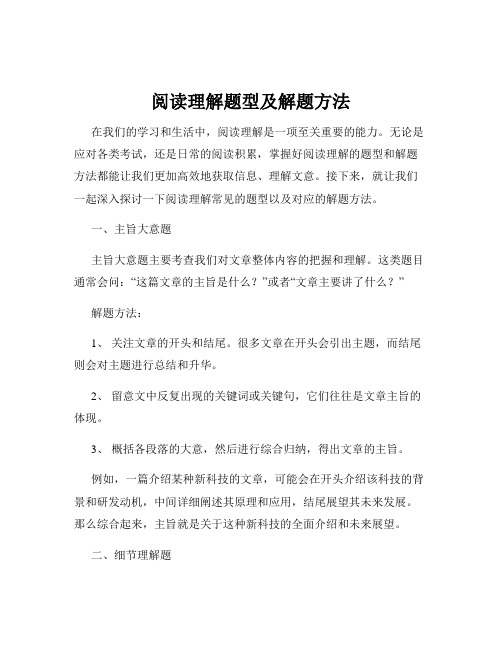
阅读理解题型及解题方法在我们的学习和生活中,阅读理解是一项至关重要的能力。
无论是应对各类考试,还是日常的阅读积累,掌握好阅读理解的题型和解题方法都能让我们更加高效地获取信息、理解文意。
接下来,就让我们一起深入探讨一下阅读理解常见的题型以及对应的解题方法。
一、主旨大意题主旨大意题主要考查我们对文章整体内容的把握和理解。
这类题目通常会问:“这篇文章的主旨是什么?”或者“文章主要讲了什么?”解题方法:1、关注文章的开头和结尾。
很多文章在开头会引出主题,而结尾则会对主题进行总结和升华。
2、留意文中反复出现的关键词或关键句,它们往往是文章主旨的体现。
3、概括各段落的大意,然后进行综合归纳,得出文章的主旨。
例如,一篇介绍某种新科技的文章,可能会在开头介绍该科技的背景和研发动机,中间详细阐述其原理和应用,结尾展望其未来发展。
那么综合起来,主旨就是关于这种新科技的全面介绍和未来展望。
二、细节理解题细节理解题侧重于考查我们对文章具体细节的掌握。
题目可能会问:“文中提到______的原因是什么?”或者“根据文章,______的特点有哪些?”解题方法:1、先根据题目中的关键词在文中定位相关段落。
2、仔细阅读定位段落,寻找与题目相关的具体信息。
3、注意对细节信息的准确理解,避免张冠李戴或曲解文意。
比如,一篇关于旅游景点的文章,题目问“该景点最吸引人的特色是什么?”我们就需要在文中找到关于景点特色的描述,准确提取出相关信息。
三、推理判断题推理判断题要求我们根据文章提供的信息进行推理和判断。
常见的问题有:“从文章中可以推断出______?”或者“作者暗示______?”解题方法:1、以文章中的事实和描述为依据,进行合理的推理。
2、注意推理的逻辑性,不能凭空臆想或过度推测。
3、对于不确定的选项,要回到文中再次确认相关信息。
举个例子,如果文章中提到一个城市的经济发展迅速,同时提到了大量的外来投资和新兴产业的兴起,我们可以推断出这个城市未来的发展前景较为乐观。
初中语文阅读理解题型分析及答题技巧分享

初中语文阅读理解题型分析及答题技巧分享阅读理解是中学语文考试中常见的题型之一,也是考查学生阅读能力和理解能力的重要途径。
掌握不同类型的阅读理解题型以及解题技巧,对学生提高语文成绩具有重要意义。
本文将对初中语文阅读理解题型进行分析,并分享一些解题技巧。
一、题型分析1. 主旨大意题主旨大意题要求理解文章的中心思想,通过整体把握文章的主题和中心,选出最能概括全文的答案。
解题时可以先通读全文,理解文章的结构和主题,重点关注文章的标题、首尾句和段落大意,以帮助确定答案。
2. 细节理解题细节理解题要求在文章中找到对应问题的具体信息细节。
解题时可以采取查找法,即根据问题的关键词在文章中进行定位,再仔细阅读相关句子或段落,找到与问题相符的答案。
注意细节题常常涉及词义理解、数字计算等,需要仔细研读,并注意排除干扰选项。
3. 推理判断题推理判断题要求根据已有信息进行推理判断。
解题时需要仔细分析文章中的事实细节和线索,并根据常识、逻辑推理来做出判断。
关注文章中的因果关系、比较对照、转折等手段,以帮助推断出正确答案。
4. 词语理解题词语理解题要求对文章中的词语进行理解。
有时题目直接问词义,有时要求根据上下文进行推测词义。
解题时可以运用词语的前后关联和上下文逻辑,理解词语在文章中的意思。
5. 短文改错题短文改错题要求根据课文的内容对文章中的错误进行改正。
解题时需要对文章的语法、词汇、标点等方面进行仔细审查,并根据常识和语言规范进行判断和改正。
二、解题技巧分享1. 认真阅读题目在答题之前,要认真阅读题目,理解题目的要求和内容。
重点关注关键词,确定解题思路。
2. 全面阅读文章在解答每个问题之前,要先全面阅读整篇文章,把握文章的主题和中心思想。
这有助于理解问题和选项,提高解题准确性。
3. 注重细节分析对于细节题,要注重细节的分析和理解。
排除干扰选项,找到与问题相符的具体信息细节。
4. 善于推理判断推理判断题需要根据已有信息进行推理判断。
初中阅读理解题型及解题技巧
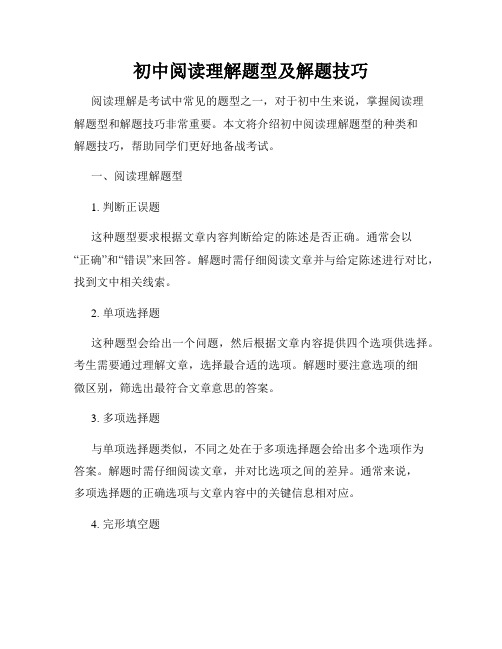
初中阅读理解题型及解题技巧阅读理解是考试中常见的题型之一,对于初中生来说,掌握阅读理解题型和解题技巧非常重要。
本文将介绍初中阅读理解题型的种类和解题技巧,帮助同学们更好地备战考试。
一、阅读理解题型1. 判断正误题这种题型要求根据文章内容判断给定的陈述是否正确。
通常会以“正确”和“错误”来回答。
解题时需仔细阅读文章并与给定陈述进行对比,找到文中相关线索。
2. 单项选择题这种题型会给出一个问题,然后根据文章内容提供四个选项供选择。
考生需要通过理解文章,选择最合适的选项。
解题时要注意选项的细微区别,筛选出最符合文章意思的答案。
3. 多项选择题与单项选择题类似,不同之处在于多项选择题会给出多个选项作为答案。
解题时需仔细阅读文章,并对比选项之间的差异。
通常来说,多项选择题的正确选项与文章内容中的关键信息相对应。
4. 完形填空题完形填空题要求考生通过阅读短文,在每个空白处选择一个最佳选项,使短文意思完整。
解题时需要通读全文,理解短文的整体意思,并根据上下文语境选择适当的选项。
二、解题技巧1. 整体把握在解答阅读理解题之前,建议先通读全文,了解文章的主题和基本内容。
这样可以帮助你更好地理解细节和筛选正确答案。
2. 标注重要信息在阅读过程中,可以使用铅笔或者记号来标注文章中的关键信息,例如人物名称、时间、地点等。
这有助于提高阅读效率,方便后续回答问题。
3. 查找线索当遇到问题时,可以通过关键词在文章中寻找线索。
文章往往会给出答案的暗示,需要仔细阅读文中的细节信息,并结合问题进行推断。
4. 筛选选项在选择题型中,考生应仔细阅读每个选项,并将其与文章内容进行对比,筛选出最符合文章意思的选项。
排除干扰选项是提高解题准确性的关键。
5. 注意语境解答阅读理解题时要注意文章的语境,特别是句子之间的逻辑关系。
有时候正确答案可能隐藏在一些转折、因果关系或条件语句等词语中。
6. 细心审题阅读理解题通常会有一些细节问题,要注意细心审题,特别是一些关键词或者连接词。
阅读理解题型分析与解题方法
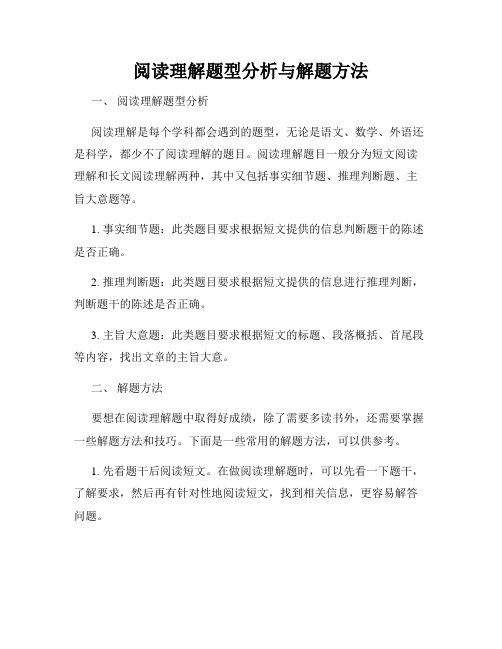
阅读理解题型分析与解题方法一、阅读理解题型分析阅读理解是每个学科都会遇到的题型,无论是语文、数学、外语还是科学,都少不了阅读理解的题目。
阅读理解题目一般分为短文阅读理解和长文阅读理解两种,其中又包括事实细节题、推理判断题、主旨大意题等。
1. 事实细节题:此类题目要求根据短文提供的信息判断题干的陈述是否正确。
2. 推理判断题:此类题目要求根据短文提供的信息进行推理判断,判断题干的陈述是否正确。
3. 主旨大意题:此类题目要求根据短文的标题、段落概括、首尾段等内容,找出文章的主旨大意。
二、解题方法要想在阅读理解题中取得好成绩,除了需要多读书外,还需要掌握一些解题方法和技巧。
下面是一些常用的解题方法,可以供参考。
1. 先看题干后阅读短文。
在做阅读理解题时,可以先看一下题干,了解要求,然后再有针对性地阅读短文,找到相关信息,更容易解答问题。
2. 留意文章的标题、首尾段以及关键词。
很多时候,文章的标题、首尾段都会有一些关键词,通过留意这些关键词,可以更好地理解文章的主旨大意,帮助解答问题。
4. 运用排除法。
在解答多项选择题时,可以先排除一些明显错误的选项,然后再仔细对比剩余的选项,找出正确的答案。
5. 注意文章的结构和连词。
文章的结构和连词往往暗示着文章的逻辑关系和段落的转折点,通过注意这些信息,可以更好地理解文章的意思。
6. 留意文章的修辞手法和表达方式。
修辞手法和表达方式直接影响文章的语义、情感和态度,通过留意这些信息,可以更好地理解文章的意义。
三、总结阅读理解是一种基本的阅读能力,对于学习和工作都非常重要。
通过掌握以上的解题方法和技巧,可以帮助我们更好地理解和解答阅读理解题,提高阅读理解的能力。
当然,最根本的方法还是多读书,提高阅读的广度和深度,从而能够更好地理解各种文章,解答各种阅读理解题。
小学阅读理解答题技巧(含18个题型)

小学阅读理解答题技巧(含18个题型)小学阅读理解答题技巧阅读理解是小学语文教学中非常重要的一部分,它不仅考察学生对于文章内容的理解能力,还锻炼学生的阅读和思维能力。
掌握一些解题技巧能够帮助学生更好地完成阅读理解题目。
本文将介绍小学阅读理解题中常见的18个题型以及相应的解题技巧。
1. 主题归纳题主题归纳题要求根据文章的内容,概括出文章的中心思想。
解题时可以将每个段落的主题进行简洁的总结,然后找出相同或相近的点,进一步概括出整篇文章的主题。
2. 细节理解题细节理解题要求根据文章中的细节来回答问题。
在解题时,要仔细阅读文章,找出问题所需要的信息,并将其准确地转化为答案。
3. 标题判断题标题判断题要求根据文章的大意判断给出的标题是否恰当。
解题时要注意带有个人情感色彩的答案通常不是最佳选择,应该选择与文章大意最贴合的选项。
4. 猜测词义题猜测词义题要求根据上下文的提示猜测生词的意思。
解题时可以通过上下文的描述、举例等方式进行推测,选择与文章内容相符合的词义。
5. 词语辨析题词语辨析题要求根据文章的语境,选择与给出词语意义相符的词语。
解题时要注意选项之间的细微差别,通过对比和推敲来选出正确的答案。
6. 文章结构题文章结构题要求根据文章的逻辑顺序,回答与文章结构相关的问题。
解题时要理清文章的主线和分支,通过对关键信息的理解来找到正确答案。
7. 根据图表回答问题根据图表回答问题的题目要求学生根据给定的图表信息,选择正确的答案。
解题时要对图表进行仔细观察,找出与问题相关的信息,并进行分析。
8. 选择恰当的标题选择恰当的标题要求学生根据文章的内容和主题选择最恰当的标题。
解题时要充分理解文章的中心思想和重点内容,确定与之相符的标题选项。
9. 补充或修改句子补充或修改句子的题目要求学生根据文章中的信息,对给定的句子进行补充或修改。
解题时要注意保持句子和段落的逻辑连贯性,选择与文章风格和语境相符合的句子。
10. 语句排序题语句排序题要求学生根据文章中的逻辑关系,对给出的语句进行排序。
阅读理解题型分类与技巧

阅读理解题型分类与技巧阅读理解是各种语言考试中常见的题型之一,它旨在考察考生对文章内容的理解能力和推理能力。
为了帮助考生更好地应对阅读理解题,本文将对阅读理解题型进行分类,并给出相应的解题技巧。
一、主旨大意题主旨大意题要求考生理解整篇文章的中心思想或主题。
解题技巧如下:1.仔细阅读文章第一段和最后一段,这两段通常包含了文章的主旨。
2.寻找高频词汇或关键词,它们通常会出现在文章的主题句中。
3.注意段落结构和语言逻辑,有时作者在文章中会明确或暗示出主题。
二、细节信息题细节信息题要求考生根据文章的具体细节进行选择或判断。
解题技巧如下:1.定位关键词,将问题中的关键词与文章中的关键词进行匹配,找到答案所在的段落。
2.注意细节信息的修饰词或定语,它们对于理解细节信息起着重要的作用。
3.排除错误选项,通常错误选项会使用与文章原文非常相似的词汇或表达方式。
三、推理判断题推理判断题要求考生根据文章中的信息进行推理或判断。
解题技巧如下:1.分析文章的逻辑关系,理解作者的观点或态度,并根据这些信息进行推理。
2.注意文章中的因果关系或转折关系,它们常常暗示了作者的推理过程。
3.灵活运用猜词和判断的技巧,根据上下文和语境进行推断。
四、态度观点题态度观点题要求考生理解作者的态度、观点或立场。
解题技巧如下:1.抓住文章中的观点词或态度表达词,例如“支持”、“反对”、“肯定”、“否定”等。
2.注意作者在文章中的陈述方式和语气,它们通常可以反映出作者的态度。
3.观察文章中的例子和细节,通过分析这些信息来推断作者的观点。
五、标题概括题标题概括题要求考生选择最能概括文章主题的选项。
解题技巧如下:1.理解文章的整体结构和各段的主题,寻找切中文章主题的词汇或表达方式。
2.排除过于绝对或夸张的选项,答案通常会选择最准确、中立的表述。
六、文段分隔题文段分隔题要求考生根据文章的段落结构和逻辑关系,将文段重新排序。
解题技巧如下:1.寻找段落之间的关键词或过渡词,它们通常暗示了文段之间的逻辑关系。
初中阅读理解题型与解题思路

初中阅读理解题型与解题思路阅读理解是初中英语考试中非常重要的一种题型,考察学生对文章的理解能力以及阅读技巧。
为了帮助同学们更好地应对阅读理解题,本文将介绍常见的初中阅读理解题型以及解题思路。
一、主旨大意题主旨大意题要求从整篇文章中归纳出文章的主题或大意。
解答这类题目时,首先需要通读全文,理解文章的结构和主要内容,然后总结文章的主题或中心思想。
常见的解题思路有:1. 注意文章的首尾段,它们通常会暗示文章的主题;2. 关注各个段落的首句和结尾句,它们往往包含了作者的观点和主题内容;3. 注意文章中的关键词和关键句,它们有助于理解文章的主旨。
二、细节理解题细节理解题要求学生从文章中找到特定的信息,通常需要根据具体的问题在文章中定位并寻找相关细节。
解答这类题目时,可以采用以下方法:1. 根据问题的关键词进行定位,找到相关的段落或句子;2. 关注文章中的数字、日期、人名、地名等具体信息;3. 注意文中的转折词、连接词等关联词语,它们可以帮助理解细节;4. 如果细节难以找到,可以先略读文章,获取整体信息,再回过头来细查相关段落。
三、推理判断题推理判断题要求学生根据文章的细节和线索进行推断和判断。
解答这类题目时,可以采用以下方法:1. 注意文章中的因果关系、逻辑关系等线索,通过推理来得出答案;2. 通过类比,将文中的情境与自己日常生活中的经验联系起来,进行推断;3. 结合文章中的信息,运用常识和逻辑进行推理。
四、态度观点题态度观点题要求学生判断作者或人物在文章中的观点、态度或立场。
解答这类题目时,可以采用以下方法:1. 注意观察文章中作者或人物的言辞、描述和情绪,推测其态度或观点;2. 关注文章中的转折词、修辞手法等,通过分析语言风格来判断立场;3. 注意文章中可能存在的隐含信息,进行综合分析。
五、文段链接题文段链接题要求学生判断两个或多个段落之间的关系,通常要求找出合适的过渡句或总结段落。
解答这类题目时,可以采用以下方法:1. 注意段落间的逻辑关系,如因果关系、转折关系、总分关系等;2. 关注段落之间的过渡词、连接词等线索,寻找段落之间的衔接点;3. 总结段落的中心思想,归纳段落之间的联系。
阅读理解常见题型及解答技巧

阅读理解常见题型及解答技巧阅读理解是英语考试中的重要组成部分,掌握各类题型及解答技巧对提高阅读成绩至关重要。
根据题目要求,阅读理解常见题型可分为以下五类:一、事实细节题这类题目要求考生根据文章内容回答具体细节问题。
解答此类题目时,应注意查找关键词,从文章中找到与问题相关的信息。
此外,还要注意文章的转折、列举等部分,这些地方往往包含重要细节。
二、推理判断题推理判断题要求考生根据文章内容和背景知识推断出作者未明确提到的信息。
解答此类题目时,要善于利用文章中的逻辑关系和线索,结合生活常识和学科知识进行推理。
避免过度主观,要根据文章事实进行判断。
三、猜测词义题这类题目要求考生根据上下文推测生词的意义。
解题时,可先从文章的主题和语境入手,判断生词在文中的作用。
接着,分析上下文,尤其是生词前后的词汇和句子,找出线索。
最后,结合词汇的用法和常识进行猜测。
四、文章主旨题文章主旨题要求考生概括文章的主题。
解答此类题目时,要全面理解文章内容,抓住文章的脉络。
关注首段中心句、段落主题句以及文章的结论部分,有助于找到文章主旨。
五、观点态度题观点态度题要求考生分析作者或某人的观点态度。
解题时,要注意文章中的观点陈述和态度表现。
分析作者的观点态度,可从词汇、语气、事实论述等方面进行。
同时,要关注作者的观点是否与我国立场一致。
掌握以上五类题型的解答技巧,并在实战演练中不断总结经验,有助于提高阅读理解的成绩。
以下是针对不同题型的实战演练及答案解析:1.事实细节题:例题:根据第三段,作者提到了哪些学习英语的方法?答案:A、参加英语角;B、观看英语电影;C、参加线上英语课程。
解析:通过查找第三段中的关键词“英语角”、“电影”和“线上课程”,可以找到答案。
2.推理判断题:例题:根据文章内容,作者对新技术的态度是什么?答案:持支持态度。
解析:从文章结尾部分可以看出,作者提到新技术为我们的生活带来便利,说明对新技术持有支持态度。
3.猜测词义题:例题:根据上下文,划线词“demonstrate”的意思是什么?答案:展示、演示。
- 1、下载文档前请自行甄别文档内容的完整性,平台不提供额外的编辑、内容补充、找答案等附加服务。
- 2、"仅部分预览"的文档,不可在线预览部分如存在完整性等问题,可反馈申请退款(可完整预览的文档不适用该条件!)。
- 3、如文档侵犯您的权益,请联系客服反馈,我们会尽快为您处理(人工客服工作时间:9:00-18:30)。
最牛英语口语培训模式:躺在家里练口语,全程外教一对一,三个月畅谈无阻!洛基英语,免费体验全部在线一对一课程:/ielts/xd.html(报名网址)Excerption快速准确理解原文是作好后面测试题目的前提,要想作好测试题目还必须首先了解测试题型以及解题的具体的步骤和方法。
一.题型阅读理解可以粗略地分成两大类:客观题(objective questions0和主观题(subjective question)。
客观题用来测度考生对原文内容中的客观事实的理解,也就是要求考生理解文章中的具体事实和抽象概念(包括词义)。
主观题用来测试考生的主观判断能力,也就是要求考生对文章的中心思想,作者的意图和态度,以及整篇文章的逻辑关系有更深的了解,根据这些进行推理和判断。
如果再分细一点,那么可以将阅读理解的测试题具体分为以下五种。
(一) 主旨大意题主旨大意题要求考生在阅读有关文章后能够概括出中心思想,确定段落大意或选定最佳标题。
主旨题的典型提问方式有:1.The best title for this passage is________2.Topic of the article is_______3.The main idea of the passage is_______4.The passage is mainly about (concerned with )_____5.The passage mainly (primarily) deals with________6.The author mainly discusses_________7.The title that best expresses the main idea is_______8.The central idea conveyed in the above passage is____-9.The author’s purpose in writing this passage is______-10. The main idea of this selection may be best expressed as_______11.What is the main topic (theme, subject, point) of the passage?12.Which of the following is the best title for this passage?13.What would be the most appropriate title for this passage?14.What does the passage mainly discuss?15.What title suits this passage best?16.Which sentence best summarizes the article?(二) 具体细节题这类问题要求考生理解与文章主题有关的事实依据,赞同反对的理由,以及找出其它有关的细节或具体的数据等。
细节题的出题类型主要有以下三种:1. 特殊疑问句以what ,who, when, how, where 等引导的问题。
A.What do we know about…?B.Why is (are)…?C.How many (much)…in this article?D.In what year…?E.In what way…?F.According to the passage, who (what ,where, when)…?2. 正误判断题通常询问文章中所述的事情是否真实,某种提法是否正确或文章(作者)是否提及某事。
A.Which of the following statements is (not )true?B.Which of the following is (not) mentioned in the article?C.Which of the following does not explain…?D.Which of the following statements is wrong according to the author?E.Which of the following in NOT listed as…?F.All of the following are true except…?G.The author mentions all of the items listed below except…?H.The author (passage) does not tell us…?3.填空题通常涉及与主题有关的事实或细节,但涉及的范围比下误判断题要广。
A.The real cause is______.B.According to the author, the techniques can be used to ______.C.The author states that______.D.The experiment shows that ________.E.Mr. X expects (hopes, wishes)______.(三)词汇题词汇题主要是测试考生根据上下文判断生词或新短词意义的能力。
做这样的题时,考生需要注意以下两点:一是要按照下文与字里行间的线索进行分析和大胆的猜测最后确定正确的含义;二是要特别注意新词汇和短语的引申意义。
有不少的词或短语考生也许见过或认识,但这些词或短语的意义在新的背景或上下文中可能与原义不同或者有进一步的引伸。
这就需要考生具有一定的判断能力才能确定一个词或短语的确切含义。
词汇题的提问方式主要有:1.What is the possible meaning of the word”…”in line….?2.Which is the probable definition of the word”…”?3.The italicized word in line…means_____.4.Which of the following is nearest (closest) in meaning to “….”?5.By “…”, the author means_________.6.The line …, the word “this (that, these, those , it , them)”stands for_______.7.The&nb sp;word (phrase)”…”probably means_______8.The word (phrase)”…”closest to ______9.The line …, the word”….”most probably means______.10.In line…, the word “…”could best be replaced by _________.(四) 断、预测和引申题这类题具有较大的难度,要求考生在理解原文的基础上,根据文章中所阐述的事实细节和上下文的暗示与线索进行综合分析,然后做出推断预测或得出合情合理的结论。
因此,考生必须细读全文,不仅要懂得文章的表层意义,还要理解深层的内含;不仅要掌握作者言明的观点倾向,还要获取字里行间隐含的信息。
但同时必须提醒考生的是切忌无根无据地随意猜想或推理,把白的东西说成是黑的,把自己的观点当做是作者的。
也就是产,考生所做的每一个推断或引申都应该是合情合理的,具有充分依据的。
这种题型常用提问方式有:1. The passage is intended to _________2. The passage implies that_______3. It can be inferred from the passage that _________.4. It can be concluded from the passage that________5. We can conclude (infer, see) from the article that_______6. The writer implies that _________7. The author suggests that _______8. An inference which may (not )be made from the article is _______9. According to the article, many people may ________10. The next paragraph would most probably deal with _______11. The paragraph preceding (following) this one may discuss?12. In the paragraph following this one ,we may expect the author to discuss________13. What does the paragraph preceding this one probably discuss?14. What does the writer imply about….?15. Which of the following can ( not )be inferred from the article?16. What conclusion can be drawn from the passage?17. Where would this paragraph most probably be found?18. Where would this paragraph most probably appear?(五)作者态度题除了第三类题型外,根据文章领会作者的态度和情绪的问题也相当难。
这类题要求考生从文章的论述方法、语气和词造句中把握作者对人与事的好恶,了解作者的态度和情感。
常用的提问方式有:1.Which of the following the author is most likely to agree with?2.The author seems to be in favor of the idea of ________3.What’s the author’s opinion (attitude)?4.What does the writer think of ….?5.The author’s attitude towards…might be best summarized as________6.In the writer’s opinion,______7.The author of the passage seems to be ____8.The tone of the author is ________9.The author’s purpose of writing this article is _______10.How does the author feel about ?11.The tone of the author can best be described as______12.What’s the tone of the passage?13.From the passage we know that the author_______--14.It can be seen from the passage that the author regards with ______15.By using the expression”…”, the author implies that ________二、解题步骤和方法归纳起来,阅读理解的解题步骤可以称之为“三步曲”:即分以下三个步骤:(1)快速阅读文章后的4~5道题目,并将题目中的关键词(一般为实词,并且含有重要信息)用笔划下来。
